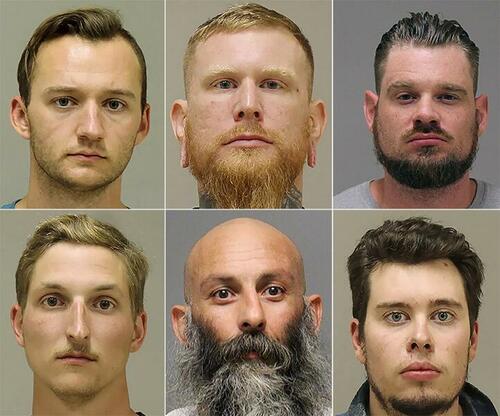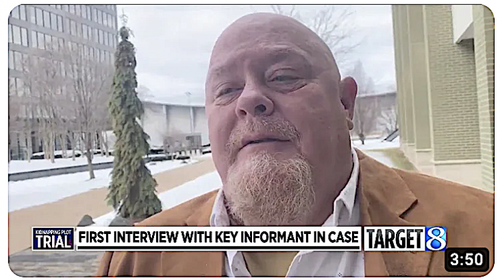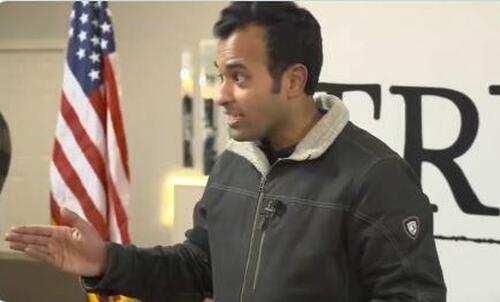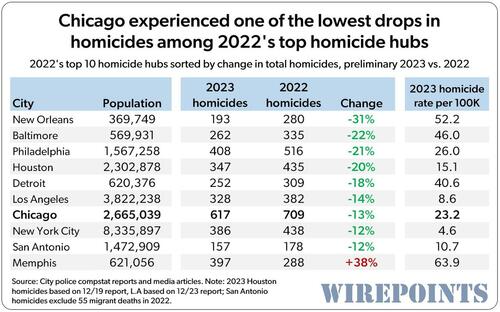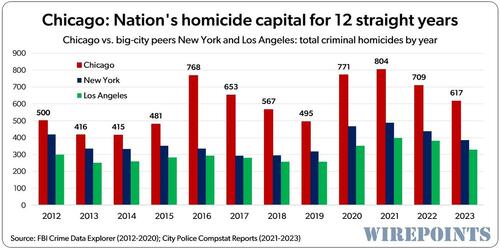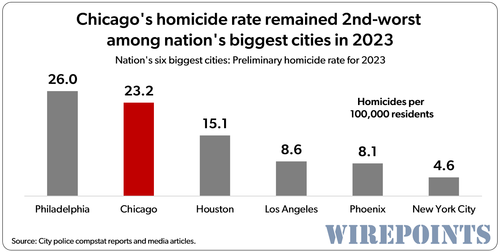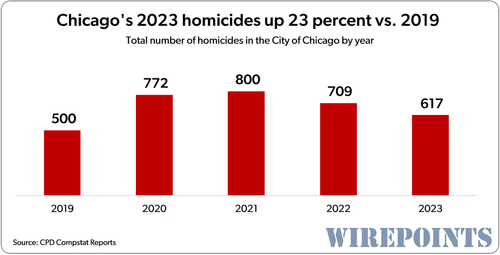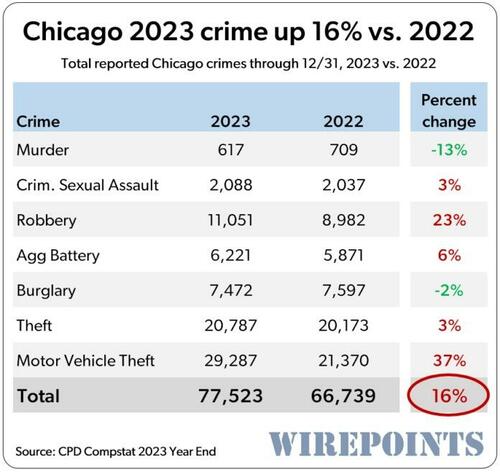The FBI-Tainted Whitmer ‘Kidnap Plot’ You’ve Heard Next To Nothing About
Authored by Julie Kelly via RealClear Investigations,
In a fiery exchange last month, CNN anchorwoman Abby Phillip told GOP presidential candidate Vivek Ramaswamy that there was “no evidence” to support his claim that federal agents abetted protesters at the Capitol on Jan. 6, 2021.
Ramaswamy shot back that the FBI conspicuously has never denied that law enforcement agents were on duty in the crowd. He argued that federal officials have repeatedly “lied” to the American people about not only that investigation but one that has gotten much less attention: the alleged failed plot to kidnap and kill Democratic Gov. Gretchen Whitmer of Michigan in 2020.
“It was entrapment,” Ramaswamy said. “FBI agents putting them up to a kidnapping plot that we were told was true but wasn’t.”
His zeroing in on the Michigan case highlighted an uncharacteristic development in contemporary politics, where progressives vigorously defend law enforcement power while conservatives view it with deep suspicion. Further, Ramaswamy’s linking of Jan. 6 and the Whitmer plot resonated with many on the right who want similarities between the two episodes exposed to the general public, especially the FBI’s reliance on informants and other paid operatives.
On Oct. 8, 2020, Whitmer announced the shocking arrests of several men accused of planning to kidnap and possibly assassinate her. The case produced alarming headlines just weeks before Election Day; Democrats, including Whitmer, used news of the plot to blame Trump for inciting violence.
Joe Biden commended the FBI for thwarting the abduction plan and, in a written statement issued the same day, claimed that “there is a through line from President Trump’s dog whistles and tolerance of hate, vengeance, and lawlessness to plots such as this one.” Biden continued that line of attack during campaign speeches in Michigan, a swing state that voted for Trump in 2016, and one Biden needed to capture to win the presidency.
In the years since the election, the national press has given little attention to the case since the initial arrests, even though court documents have recast the episode as something more sinister. Instead of a heroic effort by the FBI to safeguard the country from domestic terrorists, it now appears to have been a broad conspiracy by law enforcement to entrap American citizens who held unpopular political views.
The FBI’s tactics were first exposed by BuzzFeed in July 2021, when reporters Ken Bensinger and Jessica Garrison disclosed startling details based on court filings as the matter headed to trial. They found that the number of FBI confidential human sources involved in the scheme was equal to the number of defendants.
“An examination of the case by BuzzFeed News also reveals that some of those informants, acting under the direction of the FBI, played a far larger role than has previously been reported,” they wrote. “Working in secret, they did more than just passively observe and report on the actions of the suspects. Instead, they had a hand in nearly every aspect of the alleged plot, starting with its inception. The extent of their involvement raises questions as to whether there would have even been a conspiracy without them.”
Six men ranging in age from 22 to 44 – Adam Fox, Barry Croft Jr., Brandon Caserta, Daniel Harris, Ty Garbin, and Kaleb Franks – faced federal charges of conspiring to kidnap and use a weapon of mass destruction. Eight others faced state charges. BuzzFeed recreated much of the defendants’ movements between March and October 2020, including attendance at “field training” exercises and the surveillance of Whitmer’s properties.
While BuzzFeed offered the first account of the entrapment operation, further reporting by RealClearInvestigations, along with details revealed in court filings and trial proceedings, make the operation sound like something out of a Hollywood script. It features secretive cash payouts; drug- and booze-fueled parties; a convicted wife-beating FBI investigator; a career felon revealed as a longtime FBI asset and later accused of acting as a “double agent”; and a dramatic takedown scene at the end.
Public defenders representing the accused have identified at least 12 FBI informants and three undercover FBI agents managed by FBI officials in numerous field offices responsible for framing the men.
“In this Case, the undisputed evidence … establishes that government agents and informants concocted, hatched, and pushed this ‘kidnapping plan’ from the beginning, doing so against defendants who explicitly repudiated the plan,” defense lawyers wrote in a Dec. 25, 2021 motion. “When the government was faced with evidence showing that the defendants had no interest in a kidnapping plot, it refused to accept failure and continued to push its plan.”
At the center of the action was the FBI’s ringleader, Dan Chappel, 34 years old at the time, an Iraq war veteran and contract truck driver for the U.S. Postal Service. Chappel, the official story goes, joined a group called the “Wolverine Watchmen” in early 2020 to burnish his firearms skills. Members generally interacted on social media. The government claimed Chappel became alarmed at alleged online chatter about killing police and took his concerns to a friend in law enforcement in March 2020.
A week later, the FBI hired Chappel as an informant.
Over the course of the next seven months, Chappel “ingratiated” himself with the men, as one defense attorney described his method, with his eye particularly on Fox, 37, the reported mastermind of the plot. While the media portrayed Fox as a military leader prepping an army of “white supremacists” to overthrow state governments across the country, he was, in reality, a homeless man living in the dilapidated basement of a vacuum repair shop without running water or a toilet in a Grand Rapids strip mall. One co-defendant referred to him as “Captain Autism.”
Fox’s lawyer, Christopher Gibbons, said Chappel took on a “father figure” role to his fatherless and destitute client. Fox and Chappel exchanged thousands of texts. Chappel drove Fox, who did not own a car, to various meetups and staged events while recording every moment to preserve as evidence against him. On at least three occasions, according to testimony offered at trial, Chappel offered Fox a prepaid credit card authorized by the FBI with a $5,000 limit to help him buy guns and ammunition; Fox, despite being broke, declined each time.
Chappel, known as “Big Dan” to the group, created encrypted chats and gave real-time access to his FBI handlers working out of the Detroit FBI field office as the farfetched plan unfolded.
Informants and targets mulled over how to blow up a bridge outside Whitmer’s summer cottage; kill her security detail; take her to a nearby boat launch; and either abandon her in the middle of Lake Michigan or bring her across the lake to Wisconsin to stand a “citizen’s trial” over her COVID-19 lockdown policies. One discussion involved the implausible use of a military helicopter.
From appearances, a demonstration at the Michigan state Capitol in Lansing on April 30, 2020 might well have been a law enforcement dress rehearsal for Jan. 6. Chappel traveled to the event with three members of the Watchmen later held on state charges. Some protesters were clad in military gear and carried firearms but could not enter the building. When Chappel told his FBI handler what was happening, the FBI ordered the Michigan State Police to stand down and allow protesters inside. News photographers captured the moment when protesters “stormed” the Michigan Capitol and called out for Whitmer, resulting in the same sort of optics produced on Jan. 6.
The incident took on greater significance when it was revealed that Steven D’Antuono, head of the Detroit FBI field office during the Whitmer caper, was promoted to head up the Washington, D.C., FBI field office three months before the events of Jan. 6.
In exchange for his work, the FBI paid Chappel at least $54,000 in cash. Part of that haul included an envelope, handed over by his primary FBI handler in December 2020, filled with $23,000 in cash as payment for a mission accomplished. (Department of Justice policy requires informants to be paid in cash.). The bureau also supplied Chappel with other personal items, such as a laptop computer and tires for his car. Chappel also used a rented SUV, again funded by the FBI, to drive his targets to various locations as part of the trap.
Other informants were involved, too. A longtime FBI source named Steve Robeson, from Wisconsin, organized a “militia” meeting in Ohio in June 2020 and pressured the government’s targets, including Fox and Croft, to attend as he wore a wire to record what was said during the event.
Robeson arranged other events throughout the summer including at his remote property in Cambria, Wisconsin. He constructed a so-called “kill house” for the men to practice shooting. At one point, Robeson suggested the exercises could be used to “storm” a state Capitol building or governor’s residence. Robeson is a convicted felon several times over, including on charges of sex with a minor, with a rap sheet spanning at least nine states. He was paid roughly $20,000 for his involvement in the Whitmer caper. Prosecutors later accused him of acting as a “double agent” for allegedly tipping off one of the defendants that his arrest was imminent.
At least two other informants were tasked with managing Croft, who had been under FBI surveillance since 2019 for his “extremist” views, according to documents.
It was later revealed that the informants, including Chappel, violated FBI protocol by getting drunk and high on drugs with their targets numerous times, sleeping in the same hotel, and suggesting ways to advance the kidnapping plan. At one point, Chappel took an oath to join a separate group called the “Three Percent Patriot Militia” group – one fabricated by the FBI – then convinced Fox to become the head of the Michigan chapter, all in an effort have the men believe Chappel was part of a nonexistent “militia” movement.
Defense lawyer Gibbons described the ruse during the April 2022 trial as “free money, free bombs, daily contact for months, fake militia, build up vulnerable adult with a fake militia and a title of commanding officer, send him a federal agent to join his militia.”
More behind-the-scenes machinations were disclosed when the defense uncovered hundreds of communications between the agents and informants that showed how they guided the plot every step of the way. One text suggests that the FBI and Chappel attempted to lure a disabled Vietnam War veteran named “Frank” into initiating a similar plan against Virginia Gov. Ralph Northam. “Mission is to kill the governor specifically,” Chappel’s FBI handler texted him in August 2020.
Despite the FBI’s best efforts, the group of so-called kidnappers started to disband by August 2020. Chappel asked his handlers how to “put more pressure” on the individuals so no one would break off. To rally the increasingly uninterested group that month, Chappel proposed firing live rounds into Whitmer’s cottage and the residences of other governors, then sending the shell casings to news reporters. “Look at you bringing people together,” one of Chappel’s FBI handlers texted to him after he successfully kept the group intact.
Even that wasn’t enough to solidify a kidnapping scheme so, according to numerous exchanges between the FBI assets and trial testimony from one cooperating witness, the FBI ran another undercover agent into the plot in September 2020 to tempt the men into trying to purchase bomb-making material. During a get-together in mid-September, an FBI undercover agent known as “Red” showed the group a video of a Chevy Tahoe being blown up as a way to demonstrate his credentials.
The video had been produced by the FBI.
At the same get-together, several FBI informants and “Red” took their targets on a reconnaissance mission to stake out Whitmer’s vacation cottage, the scene of the alleged prospective crime. It was the second time Chappel drove Fox to the property. (The governor and her staff were in communication with authorities for months as the entrapment scheme was under way; the FBI installed pole cameras and 3D devices around her property to record any activity to be used as evidence.)
Chappel also drove the men to the location of the FBI arrest point in Ypsilanti, Mich., on Oct. 7, 2020, under a ruse to meet “Red,” who promised to sell them military-style garb, not explosive materials. Members of the FBI’s Hostage Rescue Team, whose missions include “high-risk arrests,” were there waiting.
But things went downhill for the government after that. Richard Trask, one of the main FBI investigators on the case, who signed the complaint against the federal defendants, was criminally charged in July 2021 for brutally assaulting his wife after a swingers’ party in Kalamazoo. Police body cam video showed a partly clothed, bloody, and apparently intoxicated Trask talking with police during his arrest. Reporters also found profane anti-Trump posts on Trask’s social media account.
Trask was removed from the case and fired by the FBI in September 2021.
Prosecutors removed Chappel’s two primary FBI handlers, Henrik Impola and Jayson Chambers, from the government’s witness list after defense attorneys accused Impola of committing perjury in a previous case and discovered that Chambers was moonlighting as head of a security firm on the side and posting inside information about the pending arrests on social media as a way to attract business.
Robeson and his wife, Kimberly, were charged with fraud in December 2021 for convincing a couple to purchase a used SUV and donate it to the Robesons’ nonexistent charity, a crime committed while Robeson was working the Whitmer plot.
Robeson also was charged separately with illegally purchasing a firearm as a felon; he threatened to plead his Fifth Amendment right against self-incrimination, so he also was not called as a witness.
By the time the federal case went to trial in western Michigan in March 2022, Ty Garbin and Kaleb Franks had accepted plea offers and planned to testify against their remaining four co-defendants: Fox, Croft, Harris, and Caserta.
Judge Robert Jonker allowed the defense to raise the entrapment issue but only after the government presented its case. That plan, however, did not last beyond the first day as defense attorneys struggled during opening remarks to explain their clients’ behavior without mentioning the key role of FBI informants and agents. Jonker suspended his own order – at which point the FBI essentially went on trial.
The trial lasted four weeks. Prosecutors insisted the defendants were solely responsible for conceiving the plan but the defense argued the group’s activities amounted to little more than “crazy, stoned talk.” Chappel took the stand for the prosecution but his testimony appeared to backfire as his central role in the plot came into view. He also admitted he became an informant to pad his resume in hopes of pursuing a job in law enforcement.
During closing arguments, the four defense attorneys emphasized the FBI’s misconduct while asking the jury for not-guilty verdicts.
“[This] is unacceptable in America,” Gibbons said during closing arguments on April 1. “That’s not how it works. They don’t make terrorists so we can arrest them.”
On April 8, 2022, after nearly four days of deliberation, the jury found Caserta and Harris not guilty on all charges; after 18 months behind bars, both men went free.
The jury, however, could not reach a unanimous verdict for Fox and Croft, resulting in a mistrial.
It was a shocking blow to the government. In what the Justice Department considered its biggest domestic terror case over the past few decades (until Jan. 6), prosecutors did not yet have a single conviction – an outcome practically unheard of for a department with a more than 90% conviction rate. “It felt so good, I was so happy. We did it, we beat them. We got justice,” Caserta told me in a post-trial interview in 2022.
Prosecutors immediately announced they would retry Fox and Croft. A different version of Judge Jonker appeared on the bench in August 2022; the trial was marked by open hostilities between the judge and defense attorneys.
At one point, Jonker took the rare step of setting a time limit for cross-examination of a key government witness. He also refused to allow defense attorneys to interview a juror suspected of bias against the defendants based on comments he had made to co-workers during jury selection and his affiliation with Black Lives Matter. Jonker repeatedly admonished both lawyers in front of the jury, accusing counsel of causing jurors to “tune out” and rushing them through important lines of questioning. Over objections by the defense, Jonker kept the man on the jury. He became the foreman.
Croft and Fox were convicted on August 23, 2022 of conspiring to kidnap and use a weapon of mass destruction, and are serving out multi-year sentences in supermax prisons reserved for the country’s worst criminals.
They are now appealing their convictions. In an August 2023 brief, Croft’s new appellate attorney, Timothy Sweeney, wrote: “It is staggering the extent to which the FBI and its agents/informants used excessive pressure, exploited the anger from COVID lockdowns and destructive summer riots, and manipulated emotional issues among vulnerable and excitable citizens. This included: nearly constant real-time monitoring of FBI’s communications with Fox, plus thousands of government-initiated texts/chats; the deployment of multiple paid agents/informants who sought to elicit and encourage extremist and violent behavior; and the FBI’s instigating, planning, promoting, and conducting of nearly all key events.”
In response, the government wrote in a December 2023 motion that “there was no evidence that government agents or informants suggested the plot or offered more than opportunity and facilities.”
Sweeney and Fox’s new appellate attorney, Steven Nolder, further accused Jonker of severely hamstringing the defense by refusing to admit into evidence the hundreds of messages that showed extensive communication between FBI agents and informants as they advanced the plot. Jonker, in both trials, denied defense motions to allow the jury to see the communications.
“These communications – constituted relevant evidence of the shocking degree to which Chambers, Chappel, and the other FBI agents/informants orchestrated this scam and generally engaged in incessant and oppressive inducement,” Sweeney wrote.
A recent verdict for the last three defendants charged in the Michigan state case may add weight to the appeal. An Antrim County jury in September 2023 found Willam Null, his brother Michael Null, and their co-defendant Eric Molitor not guilty of providing material support to an act of terror and illegally possessing firearms.
The acquittals represented another blow to the overall case and a poor showing for the government; of the 10 defendants who went to trial, five were found not guilty and two were convicted after a second trial. Four others pleaded guilty—outcomes that represent a poor showing for both the DOJ and Michigan Attorney General Dana Nessel. Nessel was so infuriated by the acquittals for the Null brothers and Molitor that she publicly criticized jurors as coming from “a very, very right-leaning county (were) seemingly not so concerned about the kidnapping and assassination of the governor.”
Fox and Croft and the DOJ have asked for oral arguments. An appellate court in western Michigan could render a decision by mid-2024. “When I look at what happened in this case,” Croft’s public defender, Joshua Blanchard, said during closing arguments in the April 2022 trial, “I am ashamed of the behavior of the leading law enforcement agency in the United States. This investigation was an embarrassment, and we have to tell them this isn’t how our country operates. This isn’t how our justice system is supposed to work.”
Tyler Durden
Wed, 01/03/2024 – 21:00
via ZeroHedge News https://ift.tt/NYAjsO0 Tyler Durden

